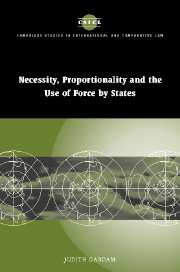Book contents
- Frontmatter
- Contents
- Foreword
- Preface
- Acknowledgments
- Table of cases
- List of abbreviations
- 1 The place of necessity and proportionality in restraints on the forceful actions of States
- 2 Necessity, proportionality and the forceful actions of States prior to the adoption of the United Nations Charter in 1945
- 3 Proportionality and combatants in modern international humanitarian law
- 4 Proportionality and civilians in modern international humanitarian law
- 5 Necessity, proportionality and the unilateral use of force in the era of the United Nations Charter
- 6 Necessity, proportionality and the United Nations system: collective actions involving the use of force
- Bibliography
- Index
- Cambridge Studies in International and Comparative Law
6 - Necessity, proportionality and the United Nations system: collective actions involving the use of force
Published online by Cambridge University Press: 16 July 2009
- Frontmatter
- Contents
- Foreword
- Preface
- Acknowledgments
- Table of cases
- List of abbreviations
- 1 The place of necessity and proportionality in restraints on the forceful actions of States
- 2 Necessity, proportionality and the forceful actions of States prior to the adoption of the United Nations Charter in 1945
- 3 Proportionality and combatants in modern international humanitarian law
- 4 Proportionality and civilians in modern international humanitarian law
- 5 Necessity, proportionality and the unilateral use of force in the era of the United Nations Charter
- 6 Necessity, proportionality and the United Nations system: collective actions involving the use of force
- Bibliography
- Index
- Cambridge Studies in International and Comparative Law
Summary
Introduction
The dispute settlement powers of the Security Council are located in Chapters VI and VII of the United Nations Charter. Chapter VII deals with non-pacific means of resolving international disputes. Article 39 sets out the jurisdiction of the Council in such matters. If the Council determines that a threat to the peace, breach of the peace, or act of aggression exists, it must take measures to restore international peace and security. To achieve this aim, the Council has available to it non-forceful measures under Article 41 and forceful measures under Article 42. These provisions are frequently referred to collectively as the enforcement powers of the Security Council. This chapter addresses the relevance of the principles of necessity and proportionality to collective actions involving the use of force. This issue is considered in the context of both ius ad bellum and IHL.
In relation to ius ad bellum, the previous chapter concluded that necessity and proportionality are well-established components of the regime governing the legitimate unilateral resort to force by States under the Charter, although allowance has to be made for considerable differences of view as to their correct application. What is unclear is to what extent necessity and proportionality can be regarded also as applicable to collective military enforcement actions and, if so, how they are to be assessed.
The requirement that the Council consider whether the use of military force is warranted is specifically articulated in the Charter.
- Type
- Chapter
- Information
- Necessity, Proportionality and the Use of Force by States , pp. 188 - 229Publisher: Cambridge University PressPrint publication year: 2004

